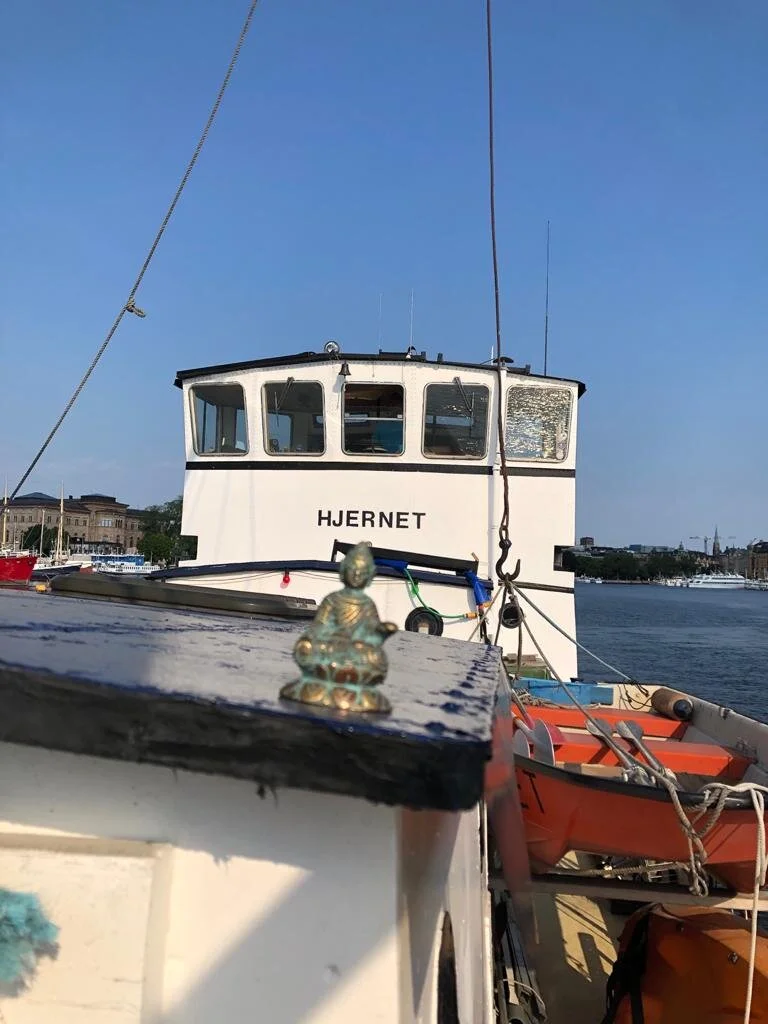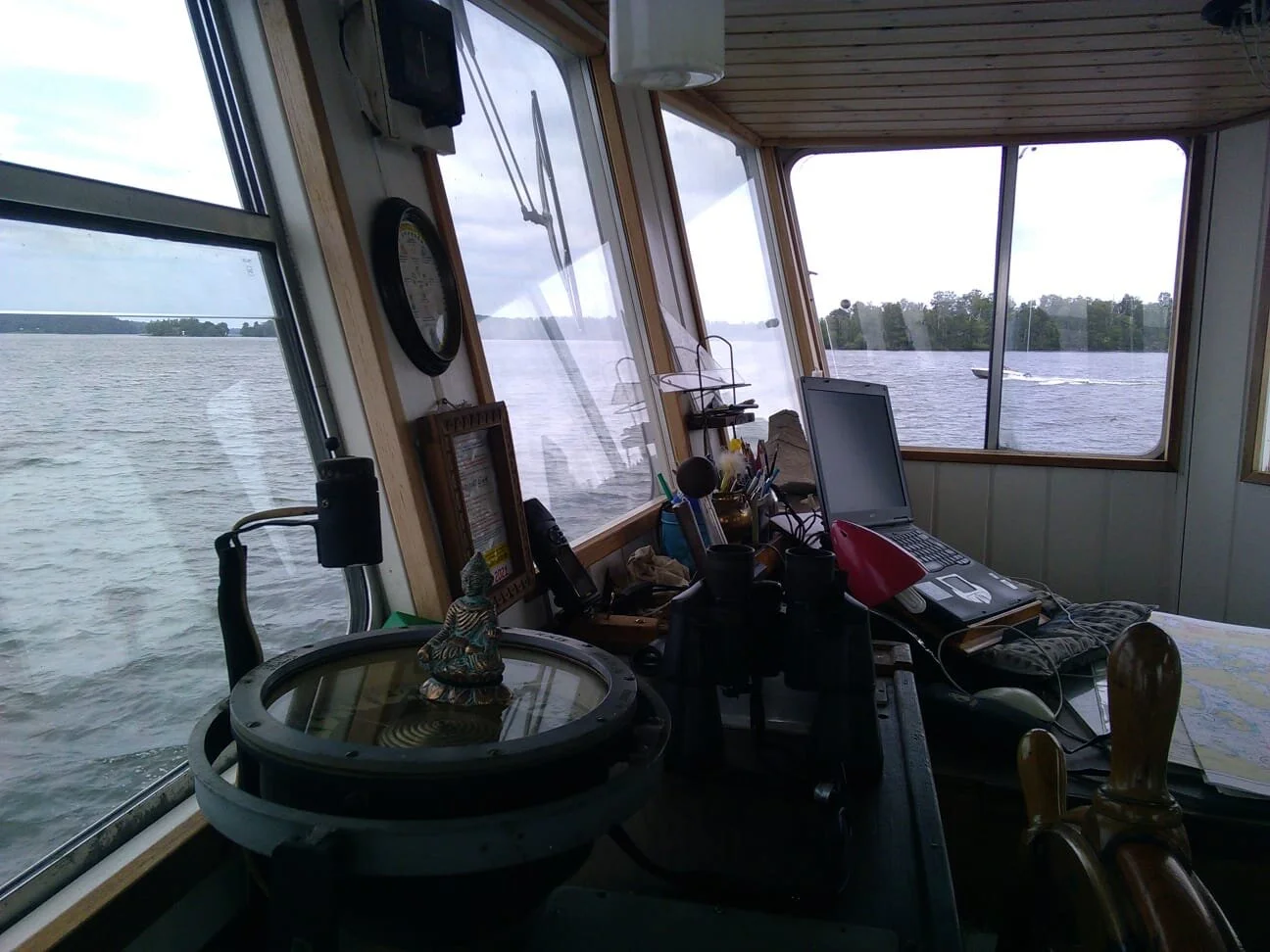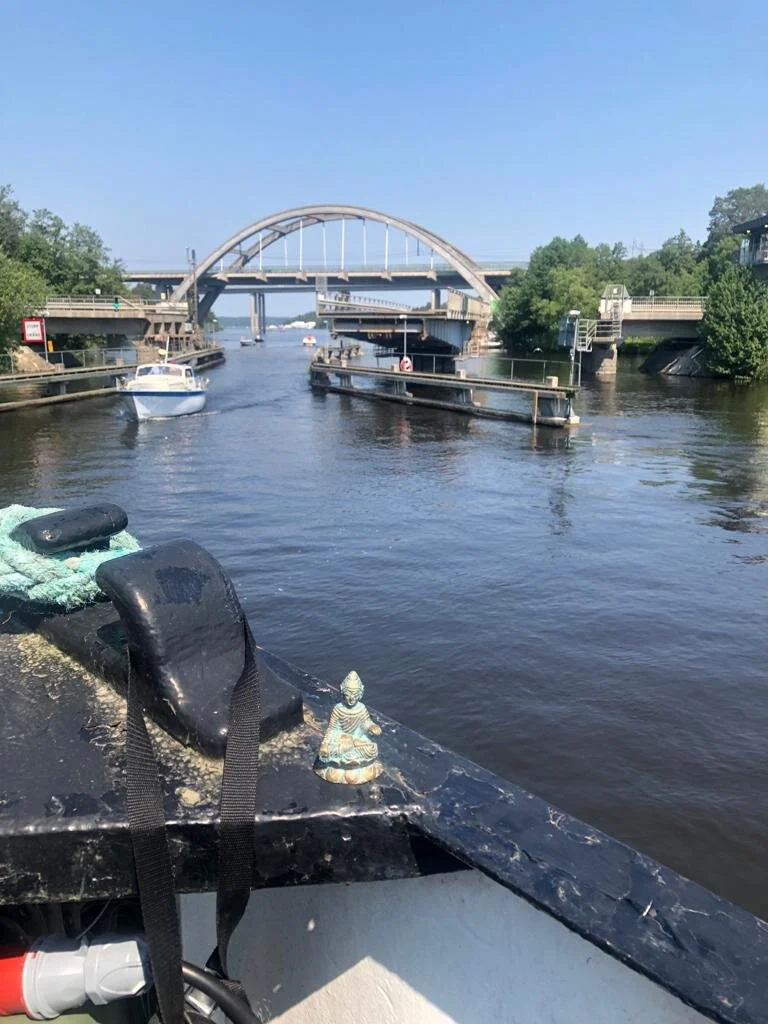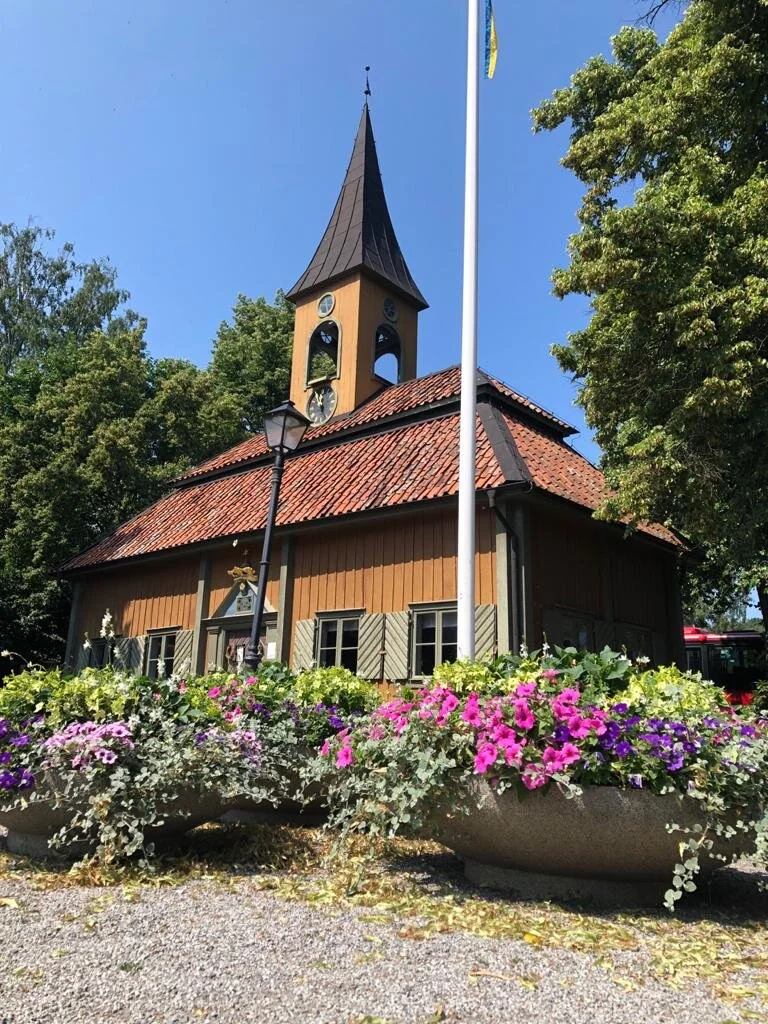Sigtuna - the First Capital of Sweden
The first exploratory journey undertaken by the statues was to, Sigtuna, established in AD 980. This would have been around 150 years after the Buddha statue arrived at Helgö. While Helgö was a small, dispersed settlement, Sigtuna was orderly and regarded as the first capital of the emerging unified country of Sweden.
We started out from Skeppsholmen, one of the most central and historical of all the islands of Stockholm City. Incidentally, this is also where the Museum of Far Eastern Antiquities is located. It has an impressive collection of Buddha statues from different parts of Asia, including a nice section with statues in the Gandhara style from northern India. A couple of hundred metres from the museum, on the eastern side of Skeppsholmen, is the home port of Jac’s 122-year-old boat, Hjernet, where it has been moored for the last 22 years.
The ship “Hjernet” built in 1899.
It is a steel ship built as a tow boat for Örebro Nya Rederiaktiebolag, and named after Sweden’s fourth largest lake; Hjelmaren. It is 22 metres long, five metres wide with a draft of just over two metres and 65 tonnes in weight. It operated with Örebro until 1956, when it was sold to the town of Vadstena on Lake Vättern, where it was converted to a freighter. She performed this role until 1970, when she was then sold to become a leisure boat based in Stockholm and the name was changed to Hjernet. For many years it has been moored at Skeppsholmen and taken on short leisure trips in Lake Mälaren and the Stockholm archipelago.
Obviously Hjernet does not in the slightest resemble a Viking ship but it sufficed. After all it is a boat built in Sweden travelling on the same waters of Lake Mälaren as the old Viking ships once did. It is certainly a very unusual boat and one of its kind. It is not built for open sea travel so the Viking ships were perhaps superior and built in different shapes and sizes to handle all lakes, rivers and the open sea. The idea of this journey is not to replicate the mode of travel of the Vikings, but to use whatever modern or slightly less modern means of transport that is available, reasonably practical and convenient. The boat Hjernet is the official designated carrier of the replica Helgö Buddha statues!
Early Saturday morning on a hot summer day in mid June we set out from Skeppsholmen and steered south with the island of Djurgården on our left. We passed the Nordic Museum, the world-famous Vasa museum and the amusement park of Gröna Lund on our way to the Hammarby sluice to enter Lake Mälaren from the Baltic Sea. At the time the Buddha statue was brought to Helgö and later when Sigtuna became the capital, the two settlements could be reached by boats directly from the Baltic Sea. A couple of hundred years later, this was no longer possible due to the post-glacial rebound, the land in between rising back up as the ice sheets melted away.
We selected the shortest route to Sigtuna via Kallhäll, the same used by the tourist boat service between Stockholm and Sigtuna which operates for six weeks during the summer. The route continued south of Södermalm and we passed two other islands of Stockholm, Kungsholmen and Essingen on our course due north-west.
A little later we passed close to the Royal Castle of Drottningholm, north-west of the centre of Stockholm.
Jac is the very experienced captain of the ship Hjernet, the official carrier of the Helgö Buddha statue replica. The vessel moves at a steady and very comfortable pace of seven knots.
A view from the wheelhouse of Hjernet.
His able crew consists of Anjali, Sara, Josefa, Jaya and I. The predicted weather conditions were good- a hot summer day with temperatures in the high twenties with few light clouds in the sky and a very slight breeze. The latter was important because there were a couple of challenging passages with either restricted height or width and where perfect handling of the boat was paramount.
The crew of Hjernet: Josefa, Sara, Anjali, Jaya and me in the background.
Once we left Stockholm behind, beaches full of sun bathers, rocks, trees and beautiful open water dominated the view. Stretches of land without buildings and settlements must look unchanged since the Viking era. One definite difference though is the large number of speed boats and jet skis, maybe of a similar nuisance factor to the scooters occupying the streets and often pavements of Stockholm. Sailing along it one very interesting feature to note of all the summer houses is the flag pole, clearly visible from the water. It is a wonderful tradition that each house has a flag pole where the national flag can be hoisted when appropriate. Were it not for this tradition the Helgö Buddha would never have been discovered by the summer house owner digging a hole in the ground for his flag pole – a rather amazing thought.
There were a few narrow passages to navigate, especially the one at Stäket, where a vehicular bridge over a narrow canal opens once an hour to allow boats to pass. Competition with the smaller recreational boats meant that Jac, had to slam on the reverse gear of the 65 tonne Hjernet to avoid a potential accident.
The narrow passage with a swing bridge at Stäket.
By mid-day we arrived at the ångbåtsbryggan (steam boat jetty), which in the olden days was where the steam boats moored. The approach to the jetty at Sigtuna was another challenging manoeuvre. Jac handled it perfectly and we were safely moored against the Sigtuna jetty within a couple of minutes. There were many people watching with huge interest in the boat from the nearby restaurants. During the evening, there was a steady stream of admirers of Hjernet at the jetty.
In 980, King Erik Edmunsson Segersäll formally founded Sigtuna as the first capital of Sweden. It was the successor to Birka, in terms of being a major trading settlement. Sigtuna is located north of Birka in the northern part of Mälaren. The main mode of transport was by water and Sigtuna benefitted from its protected location. The town was carefully laid out with more than a hundred, relatively narrow rectangular plots, around eight metres wide and 20 to 30 metres long, having access to Lake Mälaren with its water level some five metres higher than it is today. The plots were also accessed from a central road running parallel with the water line, which had the same alignment as the main street of current Sigtuna, “Stora Gatan”. In the centre of the town, the King’s residence was built. Next door, in 995, the King Olof Eriksson (Skötkonung), minted the first Swedish coins. During the next 40 years, two million silver coins were minted.
Erik Segersäll was baptised in 980 but later rescinded the Christian faith and it was not until Olof Skötkonung was baptised in 1008 that a King became committed to the Christian faith. Christianity became the prevailing religion around 1100 and construction of the first stone church, “the Bishop Church”, started. Another six churches were built soon afterwards, set back from the wooden buildings. Sigtuna was a centre for trade and regularly received traders and travellers from Russia and Byzantium. By the middle of the 13th century sea going ships could no longer reach Sigtuna as the post-glacial rebound had made the access from the Baltic Sea too shallow. Mälaren had become a lake and Stockholm, founded by Birger Jarl in 1252, became the centre for international and long-distance trading and subsequently the capital of Sweden.
The following day we took a tour of the main attractions of Sigtuna. We covered St Per’s and St Olof’s Church Ruins, Mariakyrkan, Bell Tower, Town Hall and Stora Gatan running through the town lined with old buildings. St Per’s church was completed at the beginning of the 12th century and is one of the oldest churches in Sweden. It is believed to have been the cathedral of the Archdiocese. St Olof’s Ruin, from the same period, is another impressive structure, located next to the Maria Church.
The beautiful Mariakyrkan (Maria Church), the oldest building in use in Sigtuna, was completed in the middle of the 13th century. This was the first time fired bricks were used as a building material in Sweden. On the fourth of October 2018, Mariakyrkan received a beautiful Icon of Holy Anna of Novgorod, painted in Valamo Monastery in Eastern Finland. She is remembered every year in the mass held on that date. She was born in 1001 as Ingegerd Olofsdotter, daughter of King Olof Eriksson Skötkonung, who reigned from Sigtuna. She was married to the Russian Prince Jaroslav, became the Grand Duchess of Kiev and was at the forefront of a powerful period of the Rus state. She had at least nine children, of which five sons became Russian princes and three daughters queens in Norway, France and Hungary. She later in life became a nun and was then given the name Anna and spent her time in a monastery and is believed to have died in Novgorod in 1050. Anna of Novgorod was made a saint in the Christian Orthodox Church after her death.
Sigtuna Town Hall.
The main street of Sigtuna, “Stora Gatan, is lined by old, well preserved buildings. Most tourists stroll slowly along the street stopping at shops or one of the many restaurants and cafés. After having picked up a children’s guide book to the runes of Sigtuna in the museum, Jaya was especially interested in the rune stones of which ten can be found around the centre of the town. These are the raised runic stones with engraved messages, created during the Viking era until the end of the 12th century. Most of them contain memorial messages to the fallen, many of them in battles in foreign lands to the east.
Sigtuna Town Hall is the smallest preserved town hall in Sweden. It is probably the most common and popular symbol representing Sigtuna and can be seen displayed on tourist souvenirs and official information brochures. Located in the main town square it was inaugurated in 1744 and is now a museum.
Mid-morning disaster struck. Jac suddenly experienced a severe muscular pain in his lower back and could hardly move. Standing and walking were particularly painful, while sitting somehow was slightly easier. Considering that the return journey required the captain to stand up for six hours behind the steering wheel on the bridge, Jac made the wise decision to keep the boat a further night in Sigtuna and to get some much needed rest, hoping that the back would improve. We had a wonderful lunch on deck and then left Jac to nurse his back. The following day, there were some improvement to his back, so Jac decided to return to Stockholm with the able support of the crew. By early evening, Hjernet was safely back at its usual mooring position at Skeppsholmen. It was a great end to a wonderful, successful but also somewhat dramatic first journey by the official carrier of the Helgö Buddha.




